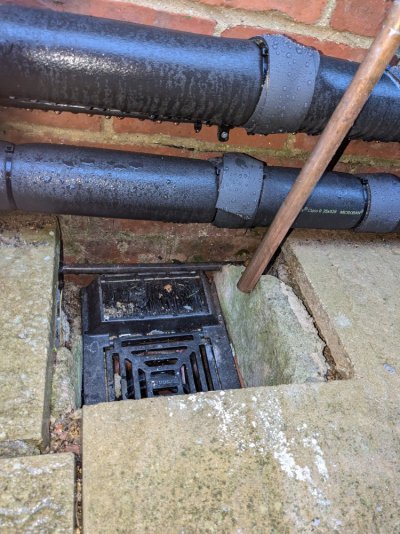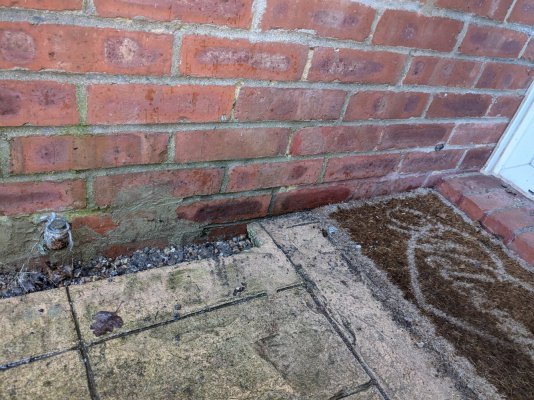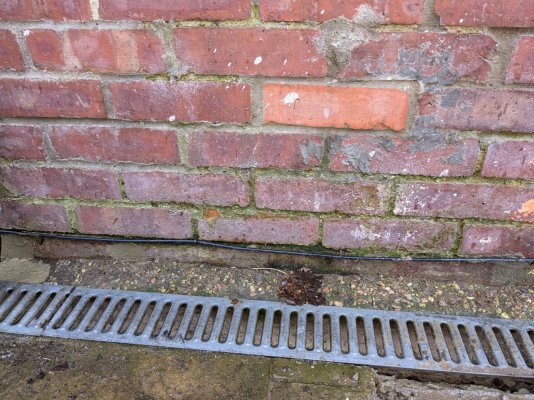thehedgehog
Member
- Messages
- 18
- Location
- Didcot
Hello all,
Firstly, very happy to have come across this forum, it's been very educational to read threads and slowly move away from ignorance.
Now to the problem.
I purchased and moved into a semi detached in late June this year. It's the first house for both me and my husband so we have little DIY experience. We have issues with damp and we suspect that it's a result from more than one source, but I'll focus on two of them in this post, namely, kitchen and fireplace hearth/living room.
Some context: the kitchen is north facing and faces the driveway. The concrete driveway is badly put and slopes towards the house. Furthermore, the ground level is too high, especially close to the entrance (see photo). I have seen traces of a DPC but I can't guarantee that it's all around. There is an aco drain (cleared and CCTVd and leading to an old school soakaway) but there's cement closest to the house and I noticed that the bricks often remain wet long after it stopped raining and covered by moss, see photos. We noticed that there were gaps in the brickwork so we repointed the poorly looking one (not sure of the ratio, perhaps 1:4 or 1:3). The inside kitchen walls facing the driveway is covered with bitumen (previous owners). The living room has suspended flooring but the kitchen has cement floor. I have been having drain specialists saying I need to put in a new soakaway, although our damp free attached neighbour has a french drain (just shingles). Now my questions related to the kitchen: is a french drain enough or do we need to update the soakaway? Do we need to remove the bitumen? The humidity in the kitchen is above 70% with window open (not sure how we can fit mechanical ventilation), but in contrast to how it was this summer before reporting, the cement flooring does not seem to be wet. As it's not wet, do we need to lower the ground level?
Living room (thanks for continuing reading this Tolstoy saga): we have two fireplaces, one open and one ceiled (chimney has been removed, unknown when, but smells very musky). The open one has been inspected by a chimney sweeper and it looks bone dry inside. The chimney has been repointed and the chimney pots capped. The hearth of the fireplace is wet, which we could also notice when we lifted a few boards around it. The floor boards touching the cement on top of the hearth are wet. At the level of the open fireplace there's a foul drain that previously had a gutter running into (which we removed) but the bricks around the drain look poor. Air vents were previously sealed with silicone but now opened. My suspicion is that there's moisture coming from the wall close to the iffy looking drain. My plan is to lift up more floorboards to see were exactly the moisture is coming from, but before I make a mess of my living room, is there possibly another explanation/did I miss anything?
Any suggestions are very well welcomed and thanks for reading a very long post.


Firstly, very happy to have come across this forum, it's been very educational to read threads and slowly move away from ignorance.
Now to the problem.
I purchased and moved into a semi detached in late June this year. It's the first house for both me and my husband so we have little DIY experience. We have issues with damp and we suspect that it's a result from more than one source, but I'll focus on two of them in this post, namely, kitchen and fireplace hearth/living room.
Some context: the kitchen is north facing and faces the driveway. The concrete driveway is badly put and slopes towards the house. Furthermore, the ground level is too high, especially close to the entrance (see photo). I have seen traces of a DPC but I can't guarantee that it's all around. There is an aco drain (cleared and CCTVd and leading to an old school soakaway) but there's cement closest to the house and I noticed that the bricks often remain wet long after it stopped raining and covered by moss, see photos. We noticed that there were gaps in the brickwork so we repointed the poorly looking one (not sure of the ratio, perhaps 1:4 or 1:3). The inside kitchen walls facing the driveway is covered with bitumen (previous owners). The living room has suspended flooring but the kitchen has cement floor. I have been having drain specialists saying I need to put in a new soakaway, although our damp free attached neighbour has a french drain (just shingles). Now my questions related to the kitchen: is a french drain enough or do we need to update the soakaway? Do we need to remove the bitumen? The humidity in the kitchen is above 70% with window open (not sure how we can fit mechanical ventilation), but in contrast to how it was this summer before reporting, the cement flooring does not seem to be wet. As it's not wet, do we need to lower the ground level?
Living room (thanks for continuing reading this Tolstoy saga): we have two fireplaces, one open and one ceiled (chimney has been removed, unknown when, but smells very musky). The open one has been inspected by a chimney sweeper and it looks bone dry inside. The chimney has been repointed and the chimney pots capped. The hearth of the fireplace is wet, which we could also notice when we lifted a few boards around it. The floor boards touching the cement on top of the hearth are wet. At the level of the open fireplace there's a foul drain that previously had a gutter running into (which we removed) but the bricks around the drain look poor. Air vents were previously sealed with silicone but now opened. My suspicion is that there's moisture coming from the wall close to the iffy looking drain. My plan is to lift up more floorboards to see were exactly the moisture is coming from, but before I make a mess of my living room, is there possibly another explanation/did I miss anything?
Any suggestions are very well welcomed and thanks for reading a very long post.



